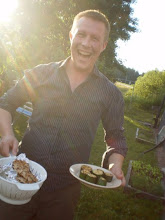One of the benefits of living in Tromsø is the short distance to the wilderness and high, snowy mountains. From late February until early June the skiing season is full on. Since there is only one little knob of a hill with a skiing lift, the proper way to go skiing is to glue a pair of skins to the underside of your skis, and walk up any mountain you see fit. Or, more likely, one you are fit to climb. Because it's hard work. Really hard.

A really nice aspect of this activity is having luch at the top of the mountain. Or slightly below, when the wind is howling at the top. When you reach the top after some hours of hard work, you are hungry, tired, and sweaty. Soon you will be very cold too, so you need to set your priorities right. So, the first thing to do is to get naked. Second priority? Get some dry clothes on, and an extra layer of warm clothes. Third priority: Lunch time. Opinions vary, but the traditional Norwegian thing to eat on top of a mountain is ice cold chocolate and oranges!!! What the hell!? Can you come up with something less satisfying than that? Cold chocolate tastes of bitumen and chalk, and oranges are totally useless fruits in the first place. Granted, most people also bring sandwiches and a thermos full of hot drink. But still.

I'm pretty convinced that I have come up the the ultimate tour food on top of a mountain. It's extremely simple too, and anyone who has tried this can attest to its satisfying powers. Actually, more like powers of ten: Good bread with heaps of thinly sliced, fatty gravlax on top. Top quality cold smoked salmon will suffice too, but gravlax has the edge. The fish should be glistening from healthy, tasty fish fat.
Here is my granny's recipe for gravlax:
300-500 g piece of absolutely fresh salmon fillet from the upper part of the fish
1 tbs caster sugar
coarsely ground black pepper
a bunch of dill, chopped
coarse sea salt
The piece of salmon should be very fresh, and have a smell somewhat reminiscent of cucumber. Preferably the piece should be from the upper part of the fish, as this part is fattier, especially the abdominal meat. Any grayish white lumps of fat can be cut away and discarded, since too much is always too much. Sprinkle a dish large enough to hold the fish with coarse sea salt and lay the fish on top, skin side down. Sprinkle with sugar, black pepper and quite generously with sea salt. Then cover the fish with the dill. Cover with cling film, place a weight on top and put in the fridge. A good weight can be made from a small plastic bag filled with water (check that there are no leaks, or you'll end up with brined salmon). After 12-24 h remove the weight, and wait another 2-4 days before it's ready. You'll know when. To serve, cut very thin slices diagonally to make them wider with a more pronounced and beautiful marbling. Best eaten on toasted good bread with a bit of butter. '
Here is a recipe for a bread that goes well with gravlax:Day 1:
100 g coarse rye flour
150 g whole wheat flour
150 g strong wheat flour
4 g fresh yeast, or 1 g dry yeast
400 g water
Mix well, cover with plastic and rest at room temperature for 12-18 hours
Day 2:
The starter from day 1
600 g strong wheat flour
20 g salt
20 g malt syrup
250-270 g water
Mix all ingredients well, and wait 20 min. Knead for 8-12 min on medium speed, or for 10+10 min by hand with a 15 min rest in between. Put the dough in a proofing box (any big plastic box with a lid will do) which has been greased with vegetable oil. Every 15-20 min, carefully,without tearing, stretch the dough and fold it like and envelope onto itself. Repeat 3-5 times. Then let the dough proof at room temperature for 2-4 hours. It contains very little yeast, and rises slowly in the beginning. When proofed, shape rolls, buns, loaves what ever you like, and place the breads on parchment. Sprinkle generously with flour and cover with plastic. After one hour, turn the oven on set to 275-300 C. When the breads have doubled, score with a serrated knife and pop them in the hot oven. Toss in half a glass of water in the bottom, and close the lid. Turn down the heat to 225 C, and bake for 25-35 minutes, depending on size. Let the bread rest on a grate for 2-4 hours before eating.








